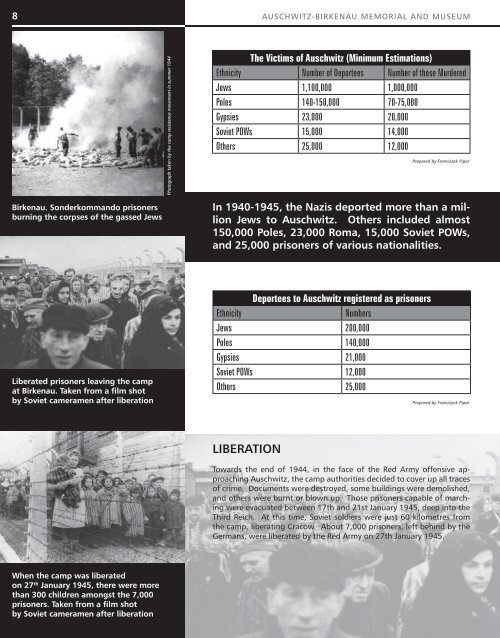You also want an ePaper? Increase the reach of your titles
YUMPU automatically turns print PDFs into web optimized ePapers that Google loves.
8 <strong>AUSCHWITZ</strong>-<strong>BIRKENAU</strong> MEMORIAL AND MUSEUM A B R I E F H I S T O R Y A N D B A S I C F A C T S 9<br />
Birkenau. Sonderkommando prisoners<br />
burning the corpses of the gassed Jews<br />
Liberated prisoners leaving the camp<br />
at Birkenau. Taken from a film shot<br />
by Soviet cameramen after liberation<br />
When the camp was liberated<br />
on 27 th January 1945, there were more<br />
than 300 children amongst the 7,000<br />
prisoners. Taken from a film shot<br />
by Soviet cameramen after liberation<br />
Photograph taken by the camp resistance movement in summer 1944<br />
The Victims of Auschwitz (Minimum Estimations)<br />
Ethnicity Number of Deportees Number of those Murdered<br />
Jews 1,100,000 1,000,000<br />
Poles 140-150,000 70-75,000<br />
Gypsies 23,000 20,000<br />
Soviet POWs 15,000 14,000<br />
Others 25,000 12,000<br />
In 1940-1945, the Nazis deported more than a million<br />
Jews to Auschwitz. Others included almost<br />
150,000 Poles, 23,000 Roma, 15,000 Soviet POWs,<br />
and 25,000 prisoners of various nationalities.<br />
Deportees to Auschwitz registered as prisoners<br />
Ethnicity Numbers<br />
Jews 200,000<br />
Poles 140,000<br />
Gypsies 21,000<br />
Soviet POWs 12,000<br />
Others 25,000<br />
LIBERATION<br />
Prepared by Franciszek Piper<br />
Prepared by Franciszek Piper<br />
Towards the end of 1944, in the face of the Red Army offensive approaching<br />
Auschwitz, the camp authorities decided to cover up all traces<br />
of crime. Documents were destroyed, some buildings were demolished,<br />
and others were burnt or blown up. Those prisoners capable of marching<br />
were evacuated between 17th and 21st January 1945, deep into the<br />
Third Reich. At this time, Soviet soldiers were just 60 kilometres from<br />
the camp, liberating Cracow. About 7,000 prisoners, left behind by the<br />
Germans, were liberated by the Red Army on 27th January 1945.<br />
Mass grave of Nazi victims discovered<br />
after the liberation of the camp.<br />
Taken from a film shot by Soviet<br />
cameramen after liberation<br />
The burial of victims from the final days<br />
of the camp. Taken from a film shot<br />
by Soviet cameramen after liberation<br />
Items belonging to victims of Auschwitz<br />
discovered after liberation<br />
Photograph: Wiesław Zieliński<br />
HISTORY OF THE MUSEUM<br />
THE BEGINNINGS<br />
A few months after the end of the war and the liberation of the Nazi<br />
camps, a group of former Polish prisoners started publicly propagating<br />
the idea of commemorating the victims of Auschwitz. As soon as it<br />
was possible, a number of them arrived at the former camp in order to<br />
protect the remaining buildings and ruins. They organised the so-called<br />
Auschwitz Permanent Protection Scheme and looked after the thousands<br />
who came flooding in soon after the end of the war in order to search for<br />
traces of close ones, to pray, and to pay homage to those murdered.<br />
Prior to the opening of the Museum, former prisoners prepared an exhibition<br />
on the premises. The exhibition opened on 14 June 1947. About<br />
50,000 people participated in the opening ceremony, including former<br />
prisoners, relatives of the murdered, visitors from almost every corner of<br />
Poland, Polish authority delegates, as well as representatives of the Main<br />
Commission for Investigation of the Nazi Crimes, the Central Jewish Historical<br />
Committee, and delegates from the British, Czechoslovakian, and<br />
French Embassies.<br />
CALLED INTO BEING<br />
On 2 July 1947, the Polish Parliament passed an Act on the preservation<br />
“for All Time of the Land and Premises of the Former Camp” and called<br />
into being the Auschwitz-Birkenau State Museum.<br />
The Museum was called into being in July<br />
1947. It comprises the two former concentration<br />
camps: Auschwitz I and Auschwitz II-<br />
-Birkenau, with a total area of 191 hectares<br />
or 477 acres. In 1979 on Polish application,<br />
the area of the former camp was entered onto<br />
the UNESCO World Heritage List.<br />
Museum or Memorial?<br />
In keeping with the Act passed by the Polish Parliament in 1947, the task of the Museum<br />
is to safeguard the former camp, its buildings and environs, to gather evidence<br />
and materials concerning Nazi atrocities, to subject them to scientific scrutiny, and to<br />
make them available to the public.<br />
Despite this, there is still much debate amongst former prisoners, museum experts,<br />
conservationists, historians, teachers, and the mass media on how to organise, run,<br />
and develop the Museum.<br />
Even before the Museum was opened, people wondered whether it should limit itself<br />
to reconstructing history, or rather explaining and translating the principal mechanisms<br />
underlying the criminal system. Views on the matter were radically different: some<br />
regarded that the area ought to be ploughed over, thus erasing all traces of genocide,<br />
others demanded that every single object be retained and protected.<br />
The very word “museum” was also discussed. Not everyone accepts the name “Auschwitz-Birkenau<br />
State Museum”. Some believe that the former camp is a cemetery, others<br />
that it is a place of memory, a monument, others still regard it as a memorial institute,<br />
a research and education centre to research the fate of those murdered. The Museum<br />
believes that its duty is to fulfil all of these functions as none cancels the others out, but<br />
rather acts as a common denominator.


